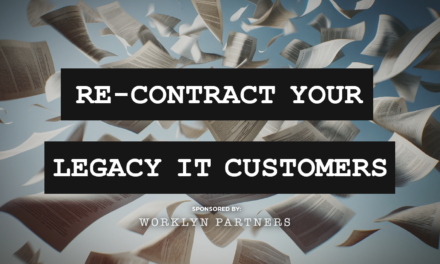Nothing sucks the momentum out of your business more than losing your biggest client. While these times can be challenging, it’s entirely possible to overcome them. It may take the right attitude, a little creativity, a lot of focus, and some brute-force sales & marketing, but you’ll get through it. Here is the best approach that I have found to overcoming such obstacles:
Don’t Panic / Appear Confident
We all know that pit that forms in your stomach the moment that you hear the news that your client is leaving. You may have seen it coming, or maybe you didn’t, but it doesn’t really matter as it always hurts the same. It’s important not to panic in these situations. Keep your emotions in check, which means not taking it personally and lashing out at your client and/or your employees.
Eventually the word starts to spread around your company about what has happened and people will start to wonder how this is going to affect them. It’s important as a leader to control this narrative, and give people the right expectations as to what is going to follow. It’s likely at this point you don’t know the full impact, so while saying “no one is going to lose their job” will put your team at peace, you shouldn’t establish this expectation if it’s not a reality. Give everyone just the right amount of comfort they need to feel at ease without understating the severity of the situation. And most of all, be honest.
Understand The “Why?”
After you’ve had a few days to cool down, try to understand why this is happening. If the customer is willing, try to schedule an exit interview with them and prepare questions that will help you better understand what went wrong. You can certainly try to salvage the deal at this point, but from my experience clients will wait to notify their existing provider after the decision has already been made.
Try to understand that your largest customers leaving is usually not an accident. It happens all the time and to almost every MSP I’ve ever met. If you were to look at your client base as a whole, the largest customers and smallest customers are the ones that have the least “fit” of any. On the high end, the customers are outgrowing you and on the lower end, you are outgrowing the customers. This is always going to be the case and the more aware you are of your client-fit the better.
Look To The Numbers
Once you have a good idea of why your client decided to leave and address any internal concerns that may have come of those conversations, start to measure the financial impact. While losing your largest customer by revenue is bound to have a negative impact in some way, it may not be as dramatic as it seems. This is because these contracts often come with large expenses in the form of COGS, overhead, and labor.
Try to get an understanding of how much of this revenue was pure profit and which expenses you will be able to shed as a result of them canceling. In the past, we have done this by exporting our P&L into excel and adjusting it manually to reflect these changes. While this may be tedious, it is the best way to get an accurate estimate of how much you are actually losing and what you need to cover to keep your business intact. Once you have a number, this becomes your “minimum recovery” amount which you will attempt to recoup any way possible.
Take A Holistic View Of The Problem
As you form your takeaways from the financial data, don’t forget to approach this problem with a wide lense. As MSPs we tend to get wrapped up in our clients, their business, their IT environment and everything that goes with it. At the end of the day though, the numbers are more formulaic than they may seem and sometimes making a few subtle moves is enough to recover. Instead of thinking “how are we going to get another big client?” you should be thinking more about how you are going to re-work what you have.
I have found that sometimes the solution is sitting right in front of us, but may be hidden in plain sight. For example, we once found that after losing a customer we could make up for it by letting another customer go whose contract was actually generating a net-loss. Even though we lost a big chunk of revenue, we were able to maintain our margin, make up for cash flow elsewhere and didn’t have to let anyone go. Taking a birds eye view of the situation and not just what you lost, will allow you to think more critically and uncover options that you wouldn’t realize you have.
Check Your Project Backlog
Before you start to even think about generating new MRR to cover your loss, first look at your project backlog and see which opportunities may help you generate some short-term cash flow. The reason that projects are your friend in this scenario is because they will help you turn your payroll expenses into more short term cash. Chances are, losing your customer may reduce the load on your team, so taking on more projects will help to keep them busy while you look for more recurring revenue.
If you are able to kick-start a few stagnating projects (or pitch new ones) and get them scheduled with the fastest turnaround time possible, it should allow you to recoup at least some of your deficit in the short-term. I realize that you can only squeeze this lemon for so long until it too runs out of juice, but this is often the shortest distance to new revenue and it should always be looked at first. I can recall many situations where we had not-so urgent improvement projects already quoted and sitting in the queue, just waiting for that final approval or to sort out scheduling of resources.
Look For Upsell Opportunities
Once you’ve exhausted your project backlog, start to look for upsell opportunities with your existing client base that will produce some kind of recurring revenue. If you routinely do QBRs with your clients then you probably already have a handle on “who needs what.” Now is the time to turn up the heat on these conversations and start to press a little harder.
What you shouldn’t do at this time is bring on any new vendor contracts that might increase your short-term liabilities. We’ve all seen these shiny new SaaS products promising new turnkey MRR for your client base. Chances are, rolling out a new product to your customers isn’t going to be easy and many vendors tend to over-sell these opportunities. Don’t let your desperation lead you to make purchasing decisions. Try to work within the tech stack that you already have until you’ve exhausted just about every upsell opportunity you have before going down this road.
Go “All-Out” Setting Appointments
Hopefully at this point you were able to boost cash flow with projects and sign some new MRR through upsells, but if not, now is the time to start looking for new business. Much like with software vendors, this may not be the time to sign a contract with a new marketing agency for an elaborate lead-gen campaign. Ironically, the best time to do that is actually when you need it the least. For now, focus on your existing contact list and any leads that may have fallen through the cracks over the last few months.
I would put all of my efforts into a combination of email and LinkedIn to start as many conversations as possible to book appointments. This requires an attack-like mindset and if you feel like it’s easy, then you probably aren’t pushing hard enough. As a Marketer, I wouldn’t necessarily recommend this as an everyday strategy, but sometime you just have to sell your way out of a jam and the best way to do that is through heavy outbound prospecting.

SPONSORED BY ZEST















